


|
Spain
Any comments or questions please contact us: kevin@sailawayonline.co.uk or ann@sailawayonline.co.uk (Please note our reply depends on available internet access, we will reply to you as soon as possible.) |
Log Entry Monday 24th December
First of all we wish to thank all for their seasonal greetings, we have received many cards, emails, telephone calls and text's - we wish all a prosperous New Year!
This time of year is a very busy time for us, the 22nd is our Wedding Anniversary and the 23rd is Ann's birthday! To celebrate we book a suit for a couple of nights in a local grand hotel "Hespria Finisterre". The suit had a sea view obviously, you could see Sailaway from one of the windows! We lived in luxury for a couple of days visiting restaurants and bars. It was a fantastic couple of days, but we both agreed, not a life style we missed.
 |
 |
 |
 |
 |
The locals were still bathing, both in the outdoor pool and the harbour!
We decorate Sailaway as is tradition for us, an investment is solar powered external lighting allows further utilisation of the decorations even at anchorage in coming years!
 |
 |
 |
 |
 |
 |
 |
 |
Log Entry Thursday 20th December
Traditional Christmas in Spain
In Spain it is a very festive time at Christmas. On Christmas Eve, traditionally,
as the stars come out, tiny oil lamps are lit in every house, and after Midnight
Mass and Christmas Dinner, streets fill with dancers and onlookers. There is
a special Christmas dance called the Jota and the words and music have been
handed down for hundreds of years. They dance to the sound of guitars and castanets.
Children think of the Three Wise Man as the gift bearers. Tradition has it that
they arrive on January 6th, the date the Wise Men gave gifts to Jesus.
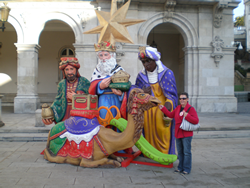 |
Shoes are filled with straw or barley for the tired camels that must carry their riders through the busy night. By morning the camel food is gone and in place of the straw or barley are presents. Shoes also may be placed on balconies on the night of the 6th January in the hope that the Wise Men will fill them with gifts.
Traditionally, most homes would have a manger, like cathedrals and churches. These are complete with carved figures. During the weeks before Christmas, families gather around their manger to sing, whilst children play tambourines and dance.
The Spanish especially honour the cow at Christmas because it is thought that when Mary gave birth to Jesus the cow in the stable breathed on the Baby Jesus to keep him warm.
Christmas is a deeply religious holiday in Spain. The country's patron saint is the Virgin Mary and the Christmas season officially begins December 8, the feast of the Immaculate Conception. It is celebrated each year in front of the great Gothic cathedral in Seville with a ceremony called los Seises or the "dance of six." Oddly, the elaborate ritual dance is now performed by not six but ten elaborately costumed boys. It is a series of precise movements and gestures and is said to be quite moving and beautiful.
Christmas Eve is known as Nochebuena or "the Good Night." It is a time for family members to gather together to rejoice and feast around the Nativity scenes that are present in nearly every home. A traditional Christmas treat is turron, a kind of almond candy.
December 28 is the feast of the Holy Innocents. Young boys of a town or village light bonfires and one of them acts as the mayor who orders townspeople to perform civic chores such as sweeping the streets. Refusal to comply results in fines which are used to pay for the celebration.
The children of Spain receive gifts on the feast of the Epiphany. The Magi are particularly revered in Spain. It is believed that they travel through the countryside reenacting their journey to Bethlehem every year at this time. Children leave their shoes on the windowsills and fill them with straw, carrots, and barley for the camels of the Wise Men. Their favourite is Balthazar who rides a donkey and is the one believed to leave the gifts.
The Spanish Christmas is Navidad, people go to church, exchange presents, and many play on swing sets set up especially for the occasion. Swinging at solstice time evokes an ancient desire to encourage the sun, urging it to "swing" ever higher in the sky.
There is no doubt that today the day for receiving gifts is split between
"tradition - the 6th January" and "else where, the 25th December"
with some clearly benefiting from both. Ann continues to remind me that "every
day is Christmas Day for me!" - a point difficult to argue?
Log Entry Wednesday 24th October
With our flight to the UK today last night Ben & Lara invited us and Dave ( Anasu) for a farewell evening on board Rosina for drinks and tapas. Lara excelled with the food as usual, Dave provided the entertainment on Ben's guitar.
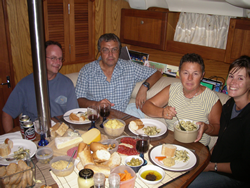 |
The evening went well into the early hours of Wednesday morning - Ann & I had to be up at 05.30 hours!
Log Entry Sunday 21st October
Two of our friends (Steven and Dina) who live in La Coruna have invited us to their country home for a barbeque. They pick us up about 1100 hours, we then travel across to La Coruna to pick up their friend Loli and her daughter Iria. Loli follows us in her own car south to the town of Oza Dos Rios. Arriving at their home we meet with Dina's grand mother, Maria, mum and dad (Jose' and Mila) and their two children Rebeca and Daniel. The welcome could not have been warmer, we felt an instant extension to their family.
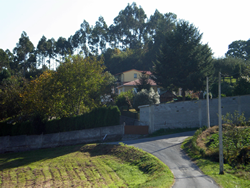 |
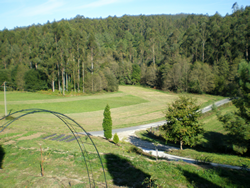 |
The house is truly in the countryside reached by a narrow track leading to the house from the single track tarmac road. The local idyllic countryside incorporates both deer and wild boar, both an issue with locally grown garden vegetables. The property benefits from a good complement of land including a woodland area, it's water supply drawn from an under ground stream passing under the property.
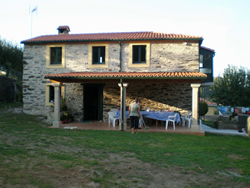 |
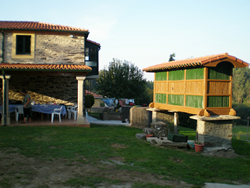 |
All have worked extremely hard on the two hundred year old property, internally displaying great character and is complemented by a historic, separate storage building typical to this area. Inside an original large oven, believed to have been used by the local people to bake their bread.
 |
Steven does us proud with regards to the meat, ribs, various sausages and chicken, as well as peppers from the garden. The girls worked well preparing vegetables salad etc, desert was home made apple pie and a chocolate cream mouse made by Steven and Dina, - perfect! Once we finish eating, Dina suggests a walk an excellent idea!
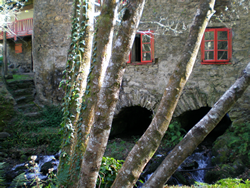 |
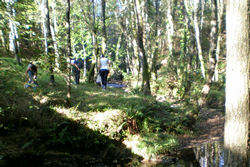 |
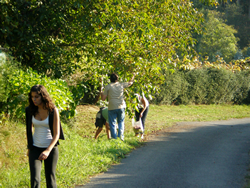 |
The countryside is beautiful, we cut through woodland and follow a stream past an old mill heading deep into the woodland. Mila explains further benefits from the land we had until now only read about. We pick plants and herbs for cooking, its explained to Ann and I how the eucalyptus plants are used to clear head colds - Fascinating! As we leave the woodlands heading back to the house we come across numerous wild fruit trees, we pick a good supply of apples and pears - if we do not eat them they fall to the ground and rot!
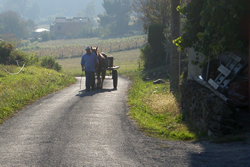 |
We make our way back fully laden with fruit, various plants and herbs, from the house we bid our thanks and farewells. Steven, Dina, Daniel and Rebeca drop Ann and I off in La Coruna, the end to a perfect and very interesting day difficult to portray effectively in words and pictures.
Log Entry Sunday 14th October
We had decided to complete our lazy weekend with a trip out on Sunday, Ben and Lara were to take us out for the day on Rosina. We traveled over to Mera across the ria's, dropped anchor off the beach and enjoyed lunch and a couple of drinks in the afternoon sun. A good day was had by all!
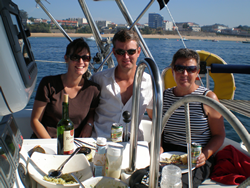 |
The day finished the weekend perfectly, back to work on Monday - plenty of jobs to do, back to the grind stone!
Log Entry Saturday 13th October
The traffic (vessels passing through, en route) in the marina is beginning to decline as winter approaches. There are a number of vessels looking to settle here until the spring as we are. Ben and Lara (of Yacht Rosina) are two Brit's, looking to move on when they complete some work on Rosina. We set our selves a challenger, to find a pub to watch the Rugby World Cup semis (England v France). Ann and I had lost interest in the series as locally the sport is not viewed at all, the only updates we had was via the internet. Rising to the challenge we began to search the city for "Irish Bars" at Ben's suggestion as our best option! Ben failed miserably - needless to say Ann and I delivered. I mentioned our plans to Dave (of Yacht ANASU) and Ian (of Yacht Lady Fisher) they were to meet us there as they knew the bar. Later that afternoon we met up on Rosina for "pre-match beers" and then off to Mathews Irish Pub in the west of the city to watch the game.
 |
 |
 |
The kick off was at 2100, so late night was a head, we were surprised how full the bar was with the entire upstairs dedicated to the game. We arrive with a couple of minutes played and had difficulty finding somewhere to stand. The English had quite a following, as did the French but the victory (14 - 9 to England) was just, Ann looked a little tired!
Log Entry Friday 12th October
Today is a national holiday in Spain, we decide to take a break from our on going list of winter jobs. We still benefit from excellent weather, cooler mornings and evenings but the mid-day temperatures still reaching the lower twenties (Celsius). The days are obviously growing shorter, dark until about 0900 hours, day light disappearing about 2000 hours in the evening. There seems to be little happening in the city today, large organised military parades are scheduled in some of the larger cities (Madrid etc). We decide to spend the day on our bicycles, to follow the coastal cycle route around the peninsular, with our lunch on our back we head off about 1030 hours. The coastal route takes you past beaches, coves and cliff tops and through Sculpture Park.
 |
 |
 |
 |
 |
 |
We ride past a number of sparsely populated beaches, still it is October! We stop and have our lunch in Sculpture Park over looking the Tower of Hercules, a light house which originated in the Roman times. The park itself is dedicated to many topics both historical, mythology and of coarse the sea, the park is considerable in size with numerous exhibits to explore.
Log Entry Sunday 7th October
Secure in our Winter Berth
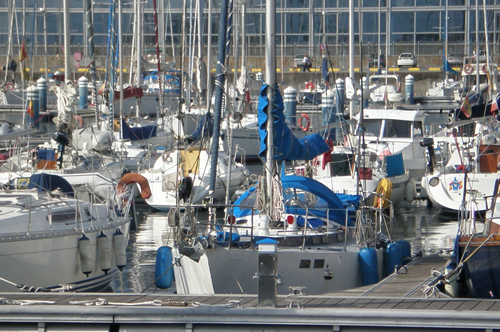 |
Our traveling by sea is now over for 2007, with over 1200 nautical miles logged since leaving Liverpool, equivalent to almost 1400 "land miles" to the non nautical readers. Sailaway will now remain in La Coruna until the Spring, we have booked flights and will be returning to the UK at the end of October for 4 weeks to visit family and friends. We have no doubt every one will be sick of us by then!
Upon returning to Sailaway we have a comprehensive list of "winter jobs" to keep us occupied, our travels in land into Spain and Portugal will be by road as apposed to sea.
Log Entry Thursday 20th September
We move back into the city marina, we need to fill our water tanks and get Lisa to the airport. After much deliberation we decide to enquire about seeing the winter through at La Coruna. We have to return to the UK quite soon for medical checks and visit family and friends etc - we will leave Sailaway for at least a month. There are a number of reasons helping us with our decision, the final cost we agree with the marina are very acceptable.
 |
 |
 |
 |
 |
 |
Once in the marina, Lisa begins a daily, morning task of feeding the fish after breakfast. She spends some time in the city it's self before her departure.
Hopefully she did not enjoy her visit too much - she may come back!
Log Entry Tuesday 18th September
We move back across the Ria to the resort of Mera and await Lisa's arrival from La Coruna airport, she finds us with ease. We are still benefiting from good settled weather at least for the first few days - we take advantage of the better weather.
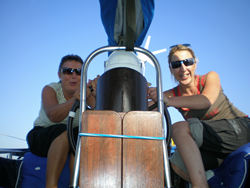 |
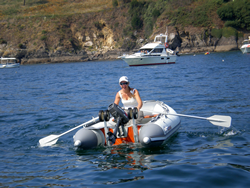 |
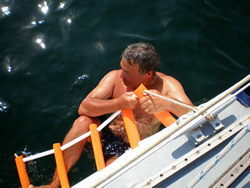 |
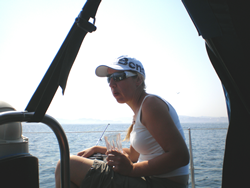 |
Ann and I had become known at a local bar/restaurant, El Mirador. The food and drinks excellent quality and value. The Chef, Adrian knew of the arrival of Lisa and promised us a meal we would never forget, the menu offered, based around a whole roast pig! It was good, how ever Lisa did struggle after "looking the pig in the eye!".
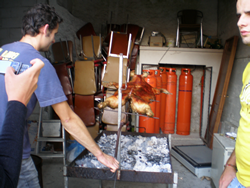 |
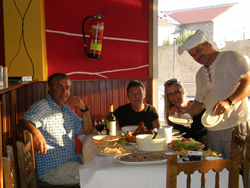 |
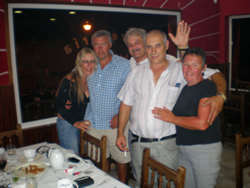 |
With the weather becoming less stable and Lisa's departure pending we head back into the city and look to show Lisa the city.
Log Entry Tuesday 11th September
We take Sailaway into the city centre (Darsena de la Marina - La Coruna) to fill our water tanks and catch up on the laundry and a couple of other jobs requiring mains electricity to complete. We only stay one night before returning to Ensenada de Mera across the Ria. We say our farewells to Pete and Shirl as they head south, continuing on their journey. We are to remain in the area for a further week as, Lisa (the eldest daughter) is to join us for a week.
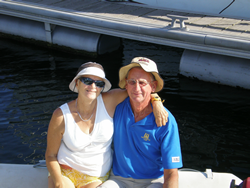 |
Log Entry Thursday 6th September
With the time to kill we take a coach to Santiago, for over a thousand years it has attracted visitors, both medieval pilgrims and today's modern tourists. According to tradition, in the third century, the tomb of Apostle James was abandoned in the forest of Libredon. It was discovered in the year 814AD by Pelayo, a hermit from San Fiz de Solovio following a vision of strange lights during the night. King of Asturias, Alfonso II the Chaste, recognising the importance of the discovery under took the creation of the first chapel, hence the founding of the city. In less than two hundred years the city became one of Christendom's acclaimed, most important centres, and the development of the "Way of Saint James". The present day Cathedral began in 1075AD and developed from that day. Today the city has a population of almost 100,000, in addition a complement of over 40,000 students. The city is very different to the rest of Northern Spain, lots of tourists and lots of English spoken, it took some getting used to. We were trying our best Spanish to people who spoke good English? Its periodic old town, with it's architecture is well worth a visit.
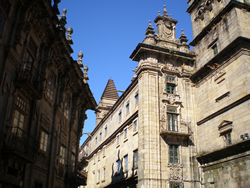 |
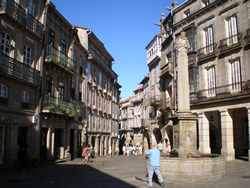 |
The Cathedral was unbelievable, but to us very commercial. With lots of little "tackie" stalls and shops within the grounds it appeared that every one was "cashing in!". Still it was very interesting
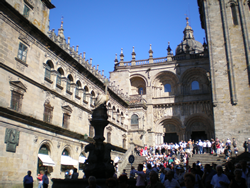 |
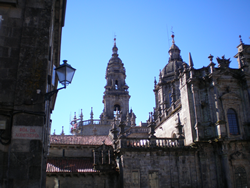 |
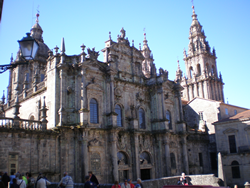 |
The largest censer in the world "Botafumeiro" fills the Cathedral with incense in an incredible flight controlled by expert "tiraboleiros".The Holy Door, with it's access from the Plaza de la Quintana, like the one in Rome, is only opened during Holy Years.
 |
 |
Log Entry Thursday 30th August
Personal circumstance now require that we stay in the local area of La Coruna until at least the 10th of September. We take the opportunity to leave the city area and explore the local resorts. Our first movement, further east into the "Ria de La Coruna" is only a short hop to Ensenada de Mera. The small holiday resort offering a both change of scenery and the shelter from the ongoing strong north, north easterly winds.
 |
 |
 |
We drop anchor in the northern sector of the bay, the town it's self is small, but very popular, the beaches, well maintained and protected from all water craft. Beyond the yellow buoy age the jet skis, water skiers etc have their fun. The town offers limited provisions but a good supply of bars and restaurants along the beach front. The resort is very popular with the people in La Coruna, they pour across the bay on a daily basis, drop anchor, spend the day swimming, sun bathing etc then return back to the city marina's in the evening leaving us with complete peace during the evening. The local fisherman rise early trailing their lines across the bay in small open boats.
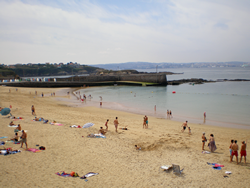 |
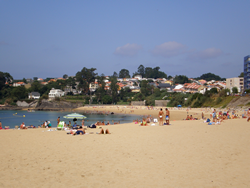 |
The beaches are, as normal well managed, cleaned early each day before the public arrive. The towns small harbour used only by the local boats and becomes an excellent area to leave our dingy when we go ashore. The beach is busy every day without exception, topless bathers (women and men) the norm.
We become "local entertainment" in the bars and especially in the local supermarket - members of staff keen to provide us with Spanish lessons and possibly helping their English! We try our best, the people are very friendly and appear to have all the time in the world for you - slightly different to La Coruna, (the city across the Ria) as one would expect.
Log Entry Saturday 25th August
The central square "Plaza de Maria Pita" in the old town is being prepared for "Fetas Maria Pita" a four day music festival, performed by various orchestras and musicians covering classical through to jazz. We decide to attend the first evening in the great square with our recently made friend Pete. Pete is on board a catamaran, from New Zealand, Pete and his wife Shirl arrived from Trinidad. Shirl had to return home for a few weeks, Pete anxiously awaits her return. We had met some days earlier, Pete invited us aboard "Jade" we had an excellent evening, Ann over indulged in Jamaican rum and suffered severely the next day. To try and "get even" Ann decided to invite Pete over and cook dinner before the concert - Ann chose sea food. Dinner went well, better still every one was ok the next day!
 |
 |
 |
The "Municipal Palace" within the square is under renovation, but the scaffold is cleverly decorated with a "completed life size image" protecting the ambiance. The square was packed to capacity, as were the surround bars, cafes and restaurants. The concert was brilliant, in 20C under the moon and stars the setting was unreal. We wandered into the city to frequent one of Pete's favourite watering holes. Within this bar they served "something" in what looked like sake bowls, costing €0.50 per shot? It was busy, it tasted good what more could you wish for?
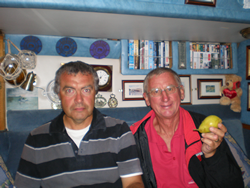 |
We made our way back to Sailaway and concluded the evening with a nightcap (or two) and retired reasonably early, in the morning that is!
Log Entry Wednesday 22nd August
We begin to find our way around the city, heavily geared to primarily, the local (Spanish) tourist market, the vast number of English as we have seen in this part of Spain mainly arrive by sea, the English language is now however, more common. We utilise the "Tourist Tram" to get around places of interest. Two of the original trams date back to 1913 & 1920, brought back into service after the re-opening of the line in 1997. The track covers about 6km giving excellent views and access to all the beaches, harbour and numerous places of interest. A journey costs €1 (single fare), no matter how long or short - excellent value and good fun. We decide to visit "Torre De Hercules" claimed as the oldest Roman lighthouse still in operation. Originally build in the 2nd century to encourage trade, today's modern tower corresponds to Eustaquio Giannini's renovation in the 18th Century - a very impressive 59m structure, we look forward to passing it by sea on our way south to Portugal.
 |
 |
 |
We spend another evening watching the sunset in our anchorage outside the city.
Log Entry Monday 20th August
La Coruna is the major city of northern Galicia and still growing rapidly from the visual signs of development. The central old town is picturesque with narrow streets, with numerous small bars and restaurants. To the north of the town is Torre de Hercules lighthouse, began by the Romans and claimed to be the oldest functioning lighthouse in the world. The cities origin began in the Phoenician times, transporting tin mined locally. It was also the departure port of the Armada, the minor irritation the British navy had to sort out! Drake did attempt to take the port after the battle but failed, but managed to leave devastation behind him. The port today is a busy fishing and commercial harbour with a constant stream of traffic, and of coarse a key port for pleasure craft.
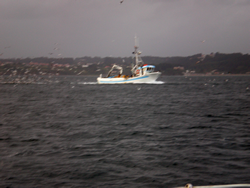 |
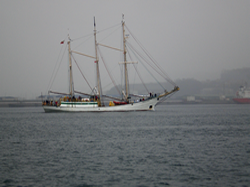 |
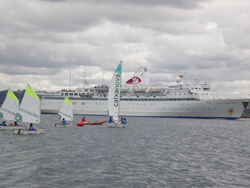 |
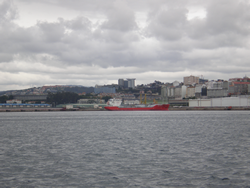 |
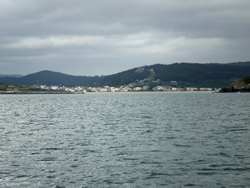 |
 |
The weather has now closed in on us, still sitting it out was not an issue for us, a few jobs to do then off into the town by dinghy. The rain came and kept us a bay until evening. We walk into the old part of the city, had dinner and found the central square, obviously with entertainment. There is some form of Folk Festival, we only catch the very end, interesting we must find out what it is all about?
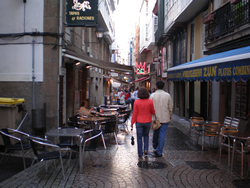 |
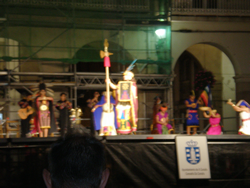 |
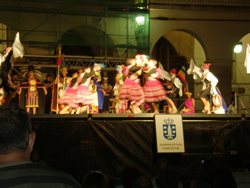 |
Log Entry Sunday 19th August
We had a terrible night, the wind swung from the north, not north east as forecast. The northerlies and resulting swell was the only direction from we we had no shelter. The motion at anchor, at times became quite violent, the noise at times un believable. The anchor held well, but we had little sleep. Our problem now was that we could not stay in the Ria's we had to move, the sea would continue to build and make it more uncomfortable. The forcast predicts northerlies force 4/5, seas going from slight to moderate. We made ready and left about 0930 with two reefs in the main and a reefed genoa, once out of the Ria, we made good progress for the next few hours. Then came the frustration, the wind velocity would drop from 25 knots plus to 4 or 5 knots (feast or famine!). The swell on our beam remained, as the waves picked us up, you looked down at the sea below, periodically we were soaked from a wave breaking into the cockpit. Having to wear our wet gear only increased the frustration as the sun came out, temperatures rose, our suits made it very uncomfortable - we chose to get wet. We dropped anchor at La Coruna about 1700 hours behind the shelter of the sea wall adjacent to the "Castillo de San Anton" and began to tidy up we had a lost nights sleep to catch up on!
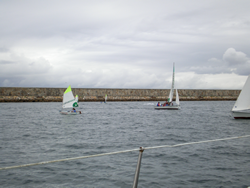 |
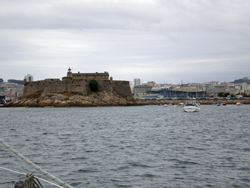 |
 |
Log Entry Saturday 18th August
We slip our lines at Viveiro about 0800 hours, our destination La Coruna sixty miles on. The forecast, light westerlies then moderate north westerlies later should see us there in good time. The sea was forecast to build but we would be safely tucked up at anchor in Coruna long before they became an issue - or so we thought? We had extremely light south westerly winds as we rounded the infamous "Punta de la Estaca de Bares". We had listened to many forecasts describing the volatile sea area around the point.
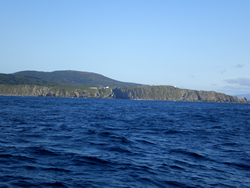 |
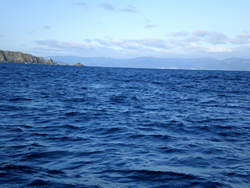 |
We rounded the most northerly point of Spain and began to trace the coast line, within an hour the wind had reached 20 knots plus, more frustrating still from the south west, not the north west as forecast! The sea began to build, first the normal long pitched swell, then as the wind increased further the waves became sharp and steep. We bashed to "wind ward", as the sea grew in size its impact as it hit our bow became greater, slowing us down almost to a stand still. It was now 1300 hours and we still had an estimated 15 hours to go with our currant rate of progress. The wind increased to 25knots, and the sea continued to grow, we headed further in land to try and make better progress within the lee on the land - not to be, the water was even more confused. We needed shelter. As we rounded "Punta de los Aguilliones" we fixed our position, a good option was "Ria De Santa Marth De Ortigueira", we had no detailed pilotage, two of the thee harbours may not suit us. The "Ria" would give us shelter from the wind and seas, we decided to head in, see what we could find - certainly an anchorage with protection would suit. We dropped anchor about 1500 hours and began to tidy up, there was two small harbours but it was not safe to try and enter without pilotage as many rocks and sand banks were evident
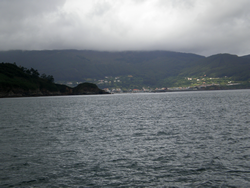 |
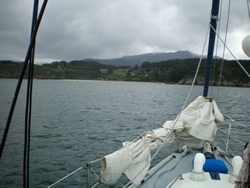 |
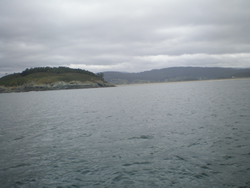 |
We were surrounded by beaches, the mountains complemented the scenery - pity about the weather. It now began to rain, chasing people from the sands. That evening we picked up a weather forecast, the promised north westerlies were coming and may reach gale force periodically, and respective seas building to "rough". Perhaps we may be here a couple of days?
Log Entry Tuesday 14th August
We look to seek shelter in the marina as there is a gale warning issued on the navtex. We prepare and raise our anchor, calling the marina on the VHF bring no answer, under stand able as we know little English is spoken. We plan to enter the small marina, if not greeted, tie up in a vacant berth and see what happens? We do so, no one greets us so we tie up in as planned. The finger pontoons are very short as most of the craft are quite short in length. It takes us a good twenty minutes to adapt a suitable combination of ropes and cleats holding us secure. Then a gentleman arrives on a bike to tell us we have to move - bless him! We do so, he places us between two six meter long open fishing boats, we protrude a good 6 meters beyond the pontoon fingers.
The winds hit as forecast, in the safety of the marina we look to explore the town and local area. The town of Viveiro is essentially commercial, administrative and tourist centre of the region. The fishing sector (fish and shellfish) provides significant employment both directly and indirectly with canning and freezing under taken locally. There is a strong dedication to the wood industry, both forestry and furniture manufacture.
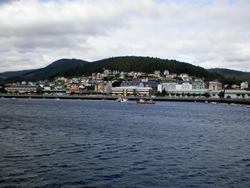 |
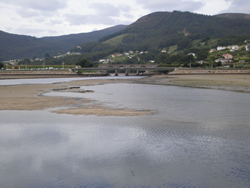 |
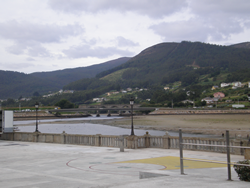 |
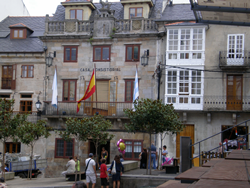 |
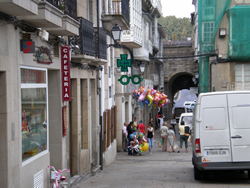 |
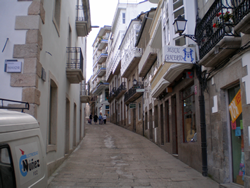 |
The town has a history dating back to the 12th Century, originally surrounded by high walls supported by six gates, fortified by the river and sea. The main bridge/entrance into the town (Misericordia Bridge) was original erected in the Roman times modified over time. Crossing the bridge you entered the town via the Carlos V Gate, originally built in the 16th Century.
 |
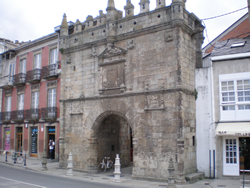 |
There are many other relics of both Roman and Medieval times, Concepcionistas Monastery, Porta Da Vila etc. We have to say Northern Spain is over looked by the British, that's obvious as when enquiring at the tourist information about British visitors we were told "They only come by boat!". We would recommend a visit, people are friendly, the culture is truly interesting, there is plenty to see and do for all. We began talking to a waiter in the town, he came to Viveiro from southern Spain, he was so proud of the streets of restaurants and bars for the British in the south. If you want that, that's fine, but in the north we see "real Spain with real Spanish people with real Spanish customs" - well worth it in our opinion.
Our arrival coincides with "The festas Patronars e de Veran" - translated into "plenty to do and see". There is organised music, processions and costume parades.
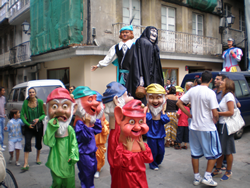 |
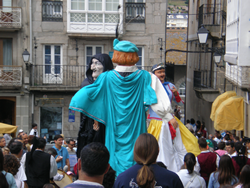 |
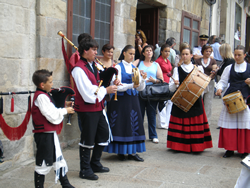 |
The entertainment continues well into the early hours, parents and children alike!
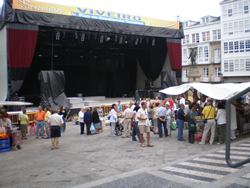 |
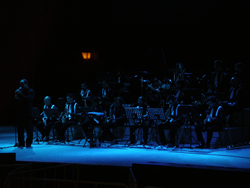 |
Log Entry Saturday 11th August
We leave Luarca to make our way further west to wards La Coruna. The forecast was promising a brisk north easterly to speed our journey. With the forecast in mind we planned an initial destination to Ria de Vivero (approx 10 hours) but we decided to possibly continue on to La Coruna a further 60 miles on. The decision based on our journey, and how we felt as we approached Vivero. We knew a couple of low pressure systems were developing out in the Atlantic - they would bring strong winds or even gales, the initial analysis suggested Sunday night, Monday. As we prepared to leave Luacro the winds are a lot lighter than forecasted however we were in a sheltered harbour, as we made our way out we had no wind at all. We had none but our own making for the vast majority of the trip. The forecasters had once again got it wrong, our thoughts were that possibly the lows were developing and influencing the weather systems far faster than anticipated. We had two options at Vivero, to anchor or to stay in the marina, as we arrived late we decided to anchor and avoid the usual fees. Making our way in land into the Ria we had to pass the port of Cillero, a major fishing port of the area.We anchored of "The Playa De Cova", the beach in front of the town of Vivero
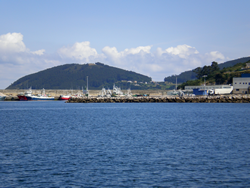 |
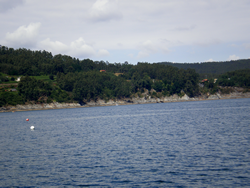 |
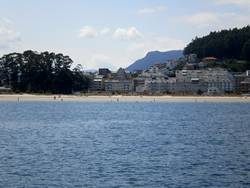 |
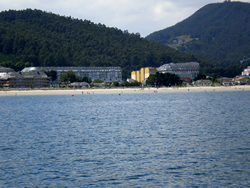 |
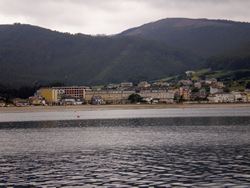 |
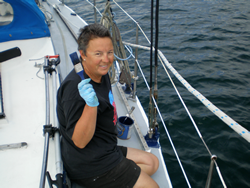 |
.The port of Cillero holds some of the largest fishing vessels we have seen on this coastline - visitors are not permitted! The navtex gives us a weather warning of possible gales in all sea areas come Monday. We decide to have "a fix and mend day!", then early Monday move into the marina to seek shelter, fill our water tanks and dispose of our rubbish We would also spend some time in the town, there was not great deal to see from the size of it? No doubt that will change in coming years as the developers are just beginning to make their mark, the occasional crane towering high above the existing buildings.
Log Entry Saturday 10th August
With a day to kill, we head into town to check the weather on the internet as VHF and Navtex broadcasts are now nonexistent, we then intend to climb a pathway to the top of the hills on the west side of the harbour. At the internet cafe we meet up with the crew of "Dyab Lavwal", a French boat moored along side us. We had earlier discussed the general problems with regards sourcing a weather forecast and had directed them to the cafe. Jean - Luc invites us aboard "to share a drink" before we both depart the next day. We accepted and continued on our trek.
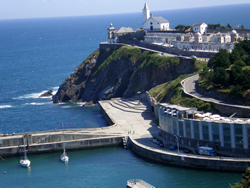 |
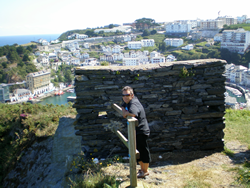 |
 |
As the day closes we head back to Sailaway and begin to make ready to leave the next day. Jean-Luc asks us over "when ever we are ready". About 19.00 hours we board Dyab Lavwal armed with a bottle of red, a number of cold beers and a couple of packets of snacks. Most of which I have to say we returned with, an excellent evening was had. We covered all topics from Anglo/French relationships to politics! Ann seemed to take a fancy to both Jean-Luc's rum and Jean-Luc? At one point I thought I had lost her altogether and she was off to France with the guys. Still, I woke up the next morning and Ann was next to me - still there is time yet!
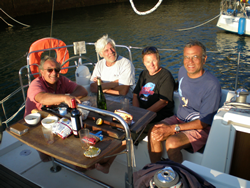 |
Left to right, Jean-Luc, Jean-Francois, Ann (my wife at the moment!) and Robert - a long journey ahead the next day for them back to France. If any of the gentleman's wife's read this they told us to say Ann was drinking the alcohol - they were drinking water????
Log Entry Tuesday 7th August
The bad weather has set in ahead, we prepare our selves for a further few days at Luarca, sit out the "marejada"ahead, translated to us as "crazy seas". There is very little shelter ahead therefore we feel that it is not worth the aggravation of trying to move on. The weather ahead is predominantly caused by the current gales in the Fitzroy sea area ahead of us "spilling" into the Biscay. We visit the Tourist Information, asking for some thing in English brings about a search through a draw to the back of the room? Out comes an A4 clump of stabled sheets, shows how often we brit's visit?
We set our self two targets, the first to visit the church and the marine cemetery on the cliff top over looking the harbour entrance, then move on to visit the "Sea Classroom - CEPESMA". Where they claim to keep the biggest exhibition of gigantic squids in Europe, with an addition 500 exhibits of sea creatures. We climb the hillside, the views are breath taking, both east and west of us as well as over the town itself.
 |
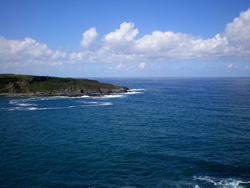 |
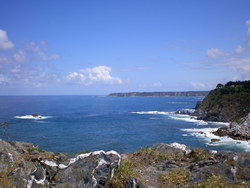 |
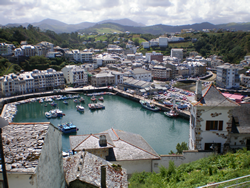 |
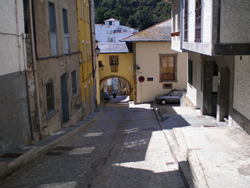 |
The walk down is obviously easier, we return to Sailaway to sit out the burning sun. The exhibition was interesting, but mainly in Spanish - it was strange in the sense that there was not one single living exhibit! Still the squid were massive!
As we sit aboard under cover reading, we are approached by three young girls swimming out to us on an deflating airbed. "Sailaway, can we come aboard, we are tired?". We drop the boarding ladder and Cristina, Rita and Cristina climb aboard - we offer them refreshments, they politely refuse. We exchange conversation, Rita speaks excellent English, here two friends are visiting for a month on holiday from Madrid. We then take them ashore in the dinghy.
 |
Log Entry Sunday 5th August
We left Cudillero about 0800, for the short hop to Luarca. The light winds turned to the west (on the nose) and began to fall of during the trip. The north west swell was at times significant, but as typical here, the result of weather far out to sea. The swell therefore has quite a long pitch, much easier to manage. The coastline was covered by cloud until we began the approach toward Luarca, we easily spotted the light house and chapel on the cliff top. We are now very "local", we complain about too much sun and today we complain because there was none at all! Our transit through the narrow channel into the harbour put the swell at our stern. Ann became excited as we surfed the waves and ran below for the camera "some thing you see in Australia" she said I think? I concentrated on our transit and the entrance between the harbour walls.
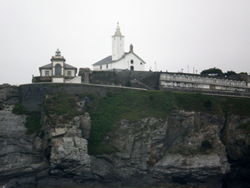 |
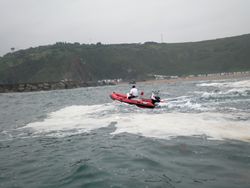 |
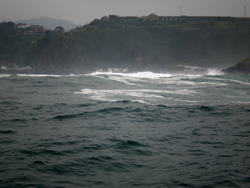 |
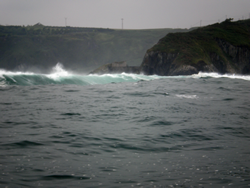 |
As we were about 300 meters from the entrance a "madman" (Harbour Official) appeared in a rib shooting over the breakers, taking off as he left the summit! He came along side and signaled to us asking if we were going in? We said yes, we could not be going any where else and we certainly could not turn around! He stayed along side us until inside, however, I must admit, and rightly so, he placed his concentration on the waves, signaling to us "it's lumpy" - at least that was our interpretation! Once inside he waved and disappeared into the inner harbour. We were to moor in the outer harbour, we had expected him to assist? Perhaps late for lunch, it was 1300 hours? The outer harbour was sizeable but with limited berthing, a friendly Frenchman helped us getting our lines a shore to harbour wall.
 |
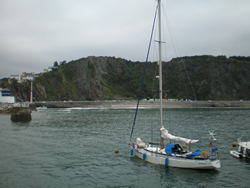 |
We shower and head into town. Walking through the inner harbour the town initially appears "tired", but, as usual the harbour is full of restaurants and bars on the water front. As we continue through the town it opens up into quite a large vibrant town, two areas of totally different contrast. We check out one of the local bars out, and return to Sailaway, the waves are now breaking over northwest harbour wall, the swell's making it's way into the harbour - a poor nights sleep ahead?
 |
 |
 |
 |
The town itself has a great history dating back to the mediaeval times, reflective in some of the town houses still in existence.
Log Entry Saturday 4th August
We rise early, there are a couple of local walks we would like to complete around the mid day sun. We are keen to climb a walk way that takes us along the narrow pathways separating the houses in the old town. The houses on the hillside have no road to service them only steps and walk ways. It must be quite a task to move house, if you have a car you certainly cannot get it near your house. Not that that really matters as the houses do not have any drives, the gardens are the size of window boxes. The climb through the houses takes you right above the town, and above the Cudillero Lighthouse, the views are fantastic.
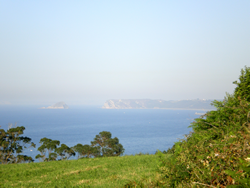 |
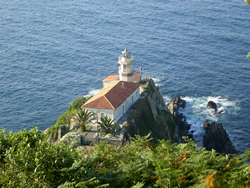 |
 |
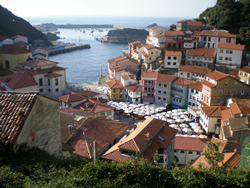 |
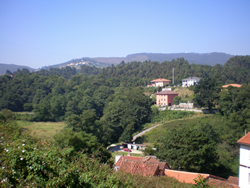 |
We discover a past mining industry also existed, nothing but a monument present today.
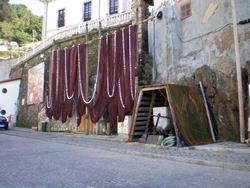 |
Log Entry Friday 3rd August
The harbour is a structure of both natural and man made, once in side it's true size becomes apparent. Our berth on the quay creates no attention at all, no fees either! A couple of smaller visiting French yachts squeeze into the anchorage, securing fenders to avoid any mishaps - we stay where we are.
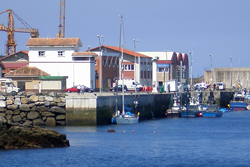 |
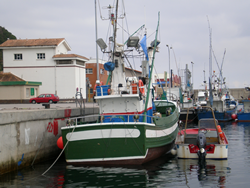 |
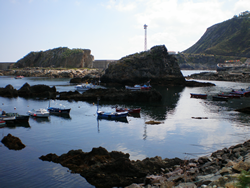 |
Form inside the harbour more of the town is visible, almost built into the hillside, the old harbour a key focal point. The new basin a fairly recent development funded by EEC money. I often wonder what the UK does with it's share? The setting is extremely dramatic, the service roads to the town twisting up the mountain side.
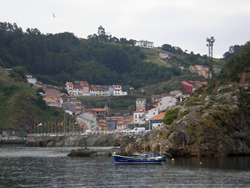 |
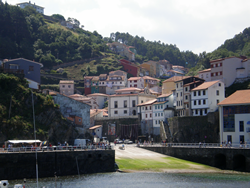 |
Cudillero is a very old town servicing the tourist industry as well as the fishing industry as a secondary. The town square being a "square of restaurants" - my turn to cook dinner this evening - I have already picked the restaurant, and of coarse it will be seafood!
 |
 |
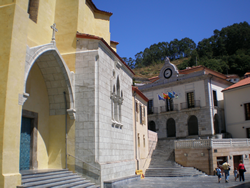 |
We are lucky and benefit from the local market produce although we have to say the fruit is as we categorise it as "ready to eat". Good but it does not last long - buy little and often seems to work best. I buy Ann a new frying pan as she has worn ours out!
The town as many others is well kept, a great pride exist - we watch them as the weed the rocks in the harbour (seriously!). We also see a "local traveler" with his life on his donkey, we can sympathise - he has a donkey, we have Sailaway.
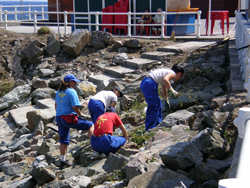 |
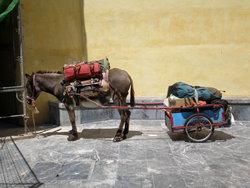 |
.We plan to stay here a couple of days and move on, the weather at this stage should stay settled over the weekend - more sun cream we fear, its much better sailing in too much sun rather than too little!
Log Entry Thursday 2nd August
Time to move on, the last couple of days of unsettled weather had convinced us to remain in Gijon. The low pressure system now moving on, a good sail to Cudillero was on the cards. Or so we thought! Cudillero was a small port less than 30 miles west along the coast. It read in the Almanac as a "small fishing port with limited along side pontoon berths, or the option to anchor of them". We left as soon as we had enough water to get out of the visitors berths, advertised as "24 hours access" only sections of the port are, certainly not the visitors berths at least for two meter draft vessels. As we left the port about 1600 hours, the wind, as normal was never in the correct or forecast position. It was lighter and more on the nose than anticipated giving us less than 3 knots of speed with every thing up - on went the engine! As we reached "Cabo Penas" and turned south west the wind had dropped off completely. As we rounded the point we suffered a knot of tide against us for almost an hour - tide had been of little significance to us for some time.
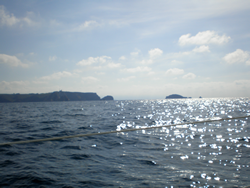 |
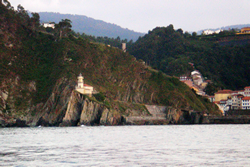 |
In due time we identified the Cudillero Lighthouse and the visible aspect of the town itself. We entered as darkness fell, ready for both pontoon berths or anchoring. The 2007 Almanac we had was some what out of date, the pontoon berths were full of local boats - our only option was to anchor as instructed. In the designated anchorage was numerous local boats on fore and aft moorings. There was already two visitors yachts anchored in the congested area, to complicate it further a steady stream of fishing boats began to return. We set and recovered our anchor five times, we could not get settled in a position in which we felt confident, we had noticed a single French yacht against the fish quay wall - we berthed along side and called it a day!
Log Entry Saturday 28th July
Gijon, one of the larger cities in northern Spain offers a great contrast, historic buildings, new development, good beaches and the typical water side development. The marina is large, but offers good berths at very reasonable pricing for visitors. As we sit here there a good mix of french and british vessels. There is obviously plans/work in progress to further extend the marina.
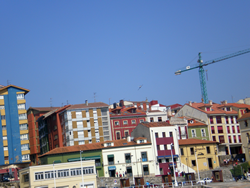 |
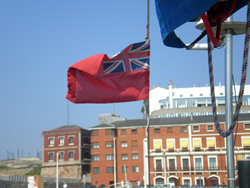 |
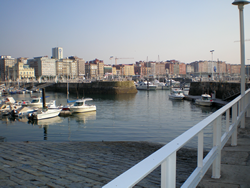 |
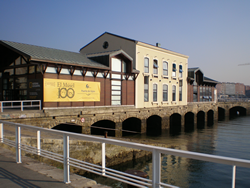 |
The city is clean busy and very friendly, twice we were caught by locals with a map in our hand. Both people asked where we were going (in Spanish) and then continue to give us directions in a language we do not under stand - and, one lady was sending us completely in the wrong direction! To save further trouble we kept the map well hidden, it was pleasant to think in a city of this size they had time for strangers (none much stranger than us two!).
The city has it's area of historic interest and modern development, the old town developed into good quality bars and restaurants.
 |
 |
 |
 |
The beaches are of good quality, very well maintained and controlled by the local lifeguard - perhaps a little short of sand?. As the tide came in the people scramble for the slipways until the tide again recedes once again exposing the valuable sand.
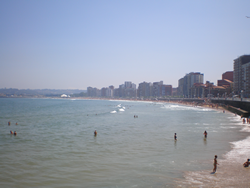 |
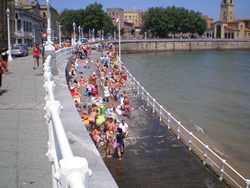 |
On an evening there is always plenty to do, local exhibitions and theaters as well as numerous, well organised street performers. On an afternoon we are buzzed by military aircraft, performing acrobatics at high speed. We are not sure where they are from but the performance is quite a deafening spectacle.
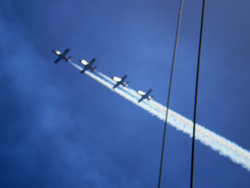 |
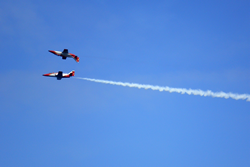 |
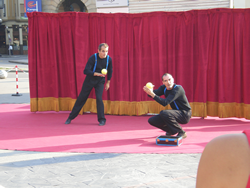 |
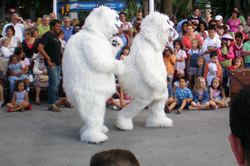 |
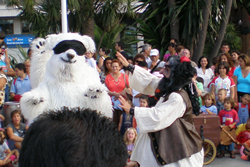 |
Log Entry Friday 27th July
We left Ribadesella yesterday as planned on the late afternoon tide for Gijon some thirty miles away. Berthed along side us was a power boat "Chuchuna III", aboard Carlos and Rosana along with their two children. They left earlier than us as their draft was significantly less than ours. When they first arrived they a couple of days previous, they had tried to moor up against a local boat, the owner was not too happy about their intension's. We invited them along side us, no sooner had they tided up then over came a chilled bottle of rose'. We filled four glasses and began to exchange conversation as best we could, Rosana claimed the more she drank the better her English became!
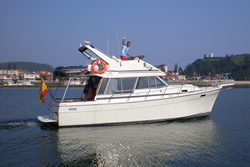 |
They were on vacation on their way home to Santander, from where we had come.
We had also met an English couple (Duncan & Rachel) on board "Sinbad". They were traveling south with identical plans to our selves. We had exchanged views and stories over a couple of drinks the evening before.
With our farewells made we left an hour before high water, with the slight swell it gave us just over a meter under our keel as we crossed the bar. The trip took us six hours, there was very little wind therefore we were forced to motor. We had a long shallow swell on the nose from the previous couple of days winds, however it did not slow us down at all. It was some what a plus as you slid down the swell you could see the log speed increase as you hit the trough the addition speed was then absorbed by the climb up the next wave. Well it kept my mind occupied - must get a life as the kids would say!
Log Entry Tuesday 24th July
It looks like we are to remain in this beautiful setting for a further day or so, the winds are dropping but the swell is forecast to remain at a couple of meters for a day or so. We entered at high water with just over two meters under the keel, with such a swell there is danger that we would ground. We are in no hurry, there is a jazz festival here over the next few days, the weather is great and to top it all it seems that berthing here is free!
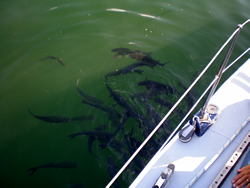 |
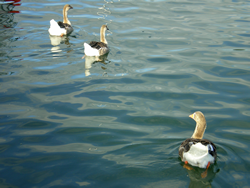 |
We rise to get on with our morning tasks of feeding our new friends. I tried for ages to catch the fish with a rod but they we too smart - got the bread every time! To out smart them Ann fed them and I just "scooped" them up with a net, catching two or three at a time. We set them free as Ann said "they were more like family!"
We then walk across the river to the local beach Playa de Santa Marina. We walk the promenade, and view the periodic mansions built on the sea front in the 1920's by the former founders of Ribadesella. These were reported as Austrians, making their fortune predominantly in the Indies via the tobacco trade. An example of the very early wood houses has also been re-created.
 |
 |
 |
Log Entry Monday 23rd July
The local weather gives a westerly force 5-7, not for us, further out to sea, gale force 8 with severe gusts. A couple of days of recreation for us, we walk up on the cliffs to the harbour entrance. They also over look the harbour and home of The Guia Chapel, passing the 18th century St Ana Chapel en route. The views are stunning of both the harbour and the backing mountains.
 |
 |
 |
It is clear to us how protected the harbour is, we watch as some people on the beach enjoying the sun, others are over come by the sand as it blows across the beach - strange to see such a contrast?
 |
 |
As we stand by the chapel, we look west as that is where we travel next, to Gijon but not for a day or so until wind and seas settle down.
On the return we enjoy a glass of the local "sidra", or cider, it is amazing how much is drunk here? It is a natural high alcohol percentage cider served at room temperature but poured with great passion. A litre costs about €2.20, it is too easy to drink in our opinion!
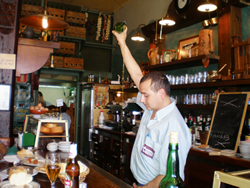 |
Log Entry Sunday 22nd July
In darkness when we entered the 200 meter gap in the cliffs it was difficult to appreciate how large the harbour was, or indeed how quaint. The harbour is not really geared for visitors, it has a very small marina for small local boats. We have to tie up along side, initially against a french boat, but as space develops we move directly alongside the wall. This allows us to get our bicycles a shore with ease. Access to Sailaway has to be managed with the tide as ladders are few, taken by the local fishing boats.
 |
 |
 |
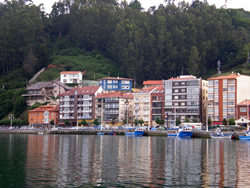 |
The town is full of history with building, in the old area dating back to the 16th century. Locally there is the "Tito Bustillo" caves complete with cave paintings dating back over 14,000 years, one of the panels is over 1km long. We make enquiries about visiting the caves, they restrict the number of visitors to conserve the caves - they are fully booked for ten days ahead!
 |
 |
There is also three local sites of focalised dinosaur footprints along a formal "Guided Dinosaur walk" complete with guided tours (in Spanish of coarse). It is for its size a busy town with what seems a strong local tourist industry.
Log Entry Sunday 22nd July
We continue our journey along the northern coast of Spain, our destination Ribadesella. The weather was not it's best, winds light and variable (they were extremely light and very variable), showers and cloudy. This time the forecast was extremely accurate! It did however give us the flattest sea we had seen for some time. We only managed about four hours sailing out of the thirteen hour trip. We had a tidal gate to make at Ribadesella. The sky remained angry through out the day, even more so in land, the mountains remained engulfed in low cloud. The rain did however bring usable wind.
 |
 |
The scenery along the coast line is very rugged (if that's how your spell it?) and dramatic, every break in cliffs appears to house either a beach or small harbour, unfortunately mostly drying therefore of no real use to us.
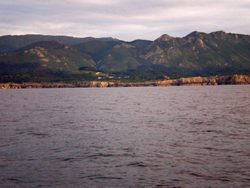 |
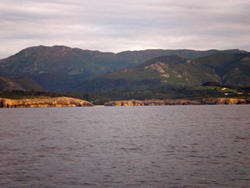 |
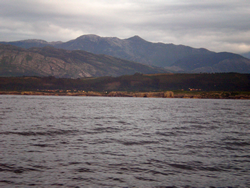 |
We arrive out side the cove in the cliffs (Ribadesella) about 22.30 hours and enter in darkness at high water, we clear the bar with less than 2.5 meters under our keel. Once inside the depth increases significantly, and, there our buoys (omitted from the pilotage) taking us past the sand banks. It's midnight before we tie up, and we still have to have our wine (me that is, Ann has taken to the Spanish brandy!) to celebrate our safe arrival and of coarse, a shower before we turn in!
Log Entry Friday 20th July
We arose to head off further west, our destination being preferably Ribadesella or if weather and time was against us Gijon. Ribadesella was a small fishing port which only gave us due to the depth of water we require one hour of access per tide according to the pilot. We had 55 nautical miles to cover and make the tidal gate, however if the weather was with us we intended to anchor off the beach (Playa de Santa Marina) and enter with ease on the Friday morning tide. We were due a light northerly breeze which would give us a good westerly sail along the coastline. We had firstly to head a further two miles up the estuary to Marina Santander to pick up some fuel, we timed our trip to allow the tide to assist us both up and down river. I took one last glance at the weather on the navtex, all change! The winds were forecast to be much stronger than yesterday, and from the west - wind and swell straight on the nose, for no thanks! The swell would also mean that Ribadesella was no longer a safe option as anchorage would not be feasible. To travel to Gijon would put us at sea for 18 hours at least. As we headed up river are minds were made up, we rounded the point, heading further into the mountains, the view was stunning, unfortunately never truly captured on a photograph. We would fuel, and seek a berth in the marina for a day or so. There was a very narrow channel into the marina from the main channel. The marina boasted some 1300 berths but not one buoy was laid to direct us in. The leading marks/lights from the main channel were far from what I would call prominent. As we tied up it began to pour down with rain and did so for most of the day and night. We registered with the Capitania, while doing so the VHF came alive with a french speaker. They were aground on the numerous sand banks, the marina sent out a rib to try and pull them off with no success. They spent the night heeled over re floating on the morning tide.
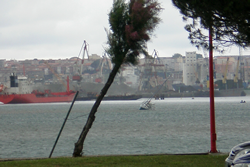 |
Awaking to sunshine the plan was to get out the bicycles and up the hillside to Parayas, we needed a few provisions it would also give us a good opportunity to see this part of the estuary. The cycle track took us along the river, through a park and up the hillside away from Santander. The contrast in building was interesting, most gardens with apple, pear and or lemon trees.
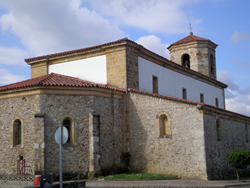 |
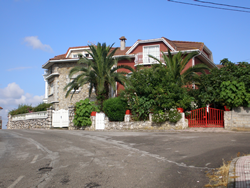 |
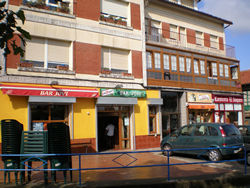 |
As we reached the summit of the hill we were provided with excellent views of the estuary, and beaches. It was to be a hell of a ride back down hill, but first lunch.
 |
 |
We continue to be amazed at how cheap every thing is compared to the UK. We saw a distinctive reduction in relative cost in France, Spain, until now was even cheaper. As we move south I believe that will change. We had spotted the perfect place for lunch on the top of the hill. We had not under taken the "siesta" as of yet, this was our perfect opportunity, we had cycled hard and needed to replace our carbohydrates! We both had their three coarse menu (as it was the only one they had!), we were even more pleased when we really enjoyed the food given to us as we had no idea what we ordered (our Spanish still really poor!). In the two hours we saw off a bottle of red, Ann also had a couple of orange juices - I refused a sweet and we both refused the coffee included in the price of €8.00 per head. The total bill came to €23.00 (about £15.00).
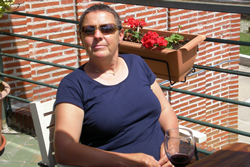 |
Ann seemed quite happy with every thing?
Log Entry Wednesday 18th July
We were awoken about 0830 by the sound of music and ships sirens. Climbing up on deck we were fascinated to see hundreds if not thousands of people along the quay side, the music was also coming from the shore - we were uncertain of what event it was? Then the sirens attracted our attention and probably about 30-50 heavily decorated boats (pleasure and commercial) began to make their way past us heading out to sea. The working, commercial vessels were even decorated!
.
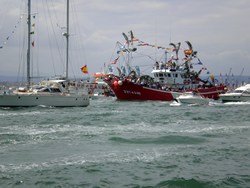 |
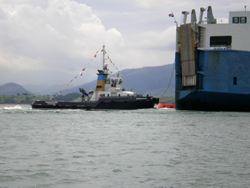 |
They returned about an hour later. We found out it had been the festival of the "Virgin del Carmen", the Spanish patron saint of the sea and all associated activities. Still tired from the journey we remained on board all day, listening to the music of the processions along the water front, piped "religious sounding" music went on until the early hours, the fireworks were fantastic.
We spent our day relaxing in the sunshine, with a glass or two of wine. Were in a lovely estuary, one side the city front, to the east beaches and to the south the picturesque mountains of northern Spain. Which unfortunately never lost their cloud covering through out our stay.
 |
 |
The next day (Tuesday) fully recovered we took our dinghy into the marina in the city centre, the marina is small and very crowded. The city itself is remarkable new and modern giving a good, controlled contrast between the "old and the new". English is hardly spoken here, we have to begin to adapt from French to Spanish - we find this difficult as the french words keep sliding in!
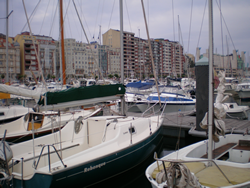 |
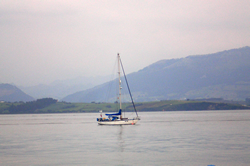 |
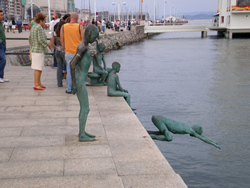 |
Further up the estuary are the commercial docks and home of the fishing fleet, traffic is heavy on the river. We see vessels registered locally in Europe, USA, Canada and Panama.
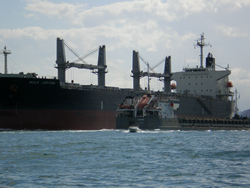 |
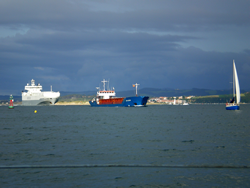 |
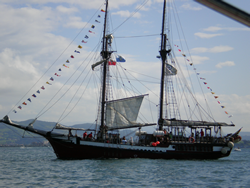 |
Commercial and pleasure craft seem to work well, perhaps a little too close for my liking at times?
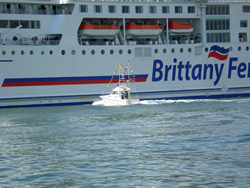 |
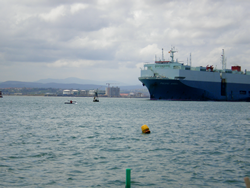 |
Log Entry Monday 16th July
We left Les Sables about 0900 hours as planned, in theory giving us an entrance to Santander in daylight late in Sunday evening. The weather had and was forecast to remain stable over the next few days. The wind forecast to be light (SSW - WNW, variable during mid day - both days) we expected to motor for quite a high proportion of the trip (Wind - feast or famine!). The trip was uneventful for most most of the day until about 1630 hours we received an unexpected visitor.
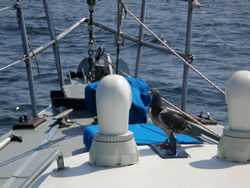 |
A pigeon took to our genoa sheet but was able to hold it's perch, it dropped to our decks and wandered around. We tried to feed it, it carried two green ring tags (one one each leg), as we approached it flew off, circled then landed again on Sailaway. We felt it was either tired, disorientated or just lazy! After an hour or so it flew off towards northern Spain heading far west of our destination - some way for it to go we guessed?
As darkness fell the wind increased from the south west far beyond the forecast, the swell built, the wind fell off but the resulting swell stayed with us during the night. We enjoyed (fortunately from a distance) fascinating electrical storms heading north, passing to the east and west of us. The morning brought light winds, we were forced to motor, the lack of wind making it unrealistic to seek stability from our sails as the resulting crashing and banging of both boom and/or sails was now common to us. We were against putting Sailaway and our nerves to such ordeals, we motored managing the swell.
We continued on through Sunday until late afternoon, the wind increased from the north west up to 25knots, we reefed and took on the resulting broadside swell. It was warm but we had to put on our wet weather gear and closed our hatches as breaking waves flooded the cockpit (and us!). At about 1800 hours we spotted through the cloud the mountains of northern Spain, the wind dropped off to about 6 knots or less, the resulting swell stayed with us, and of coarse back up went the canvas, and it rained! We entered the estuary in darkness with an annoying swell and no wind at all. Santander has four marina's, two too small for us, a third a further 3 miles up river. We made for an anchorage/visitors buoys in the town centre as the marina offered no visitors berths - we tired up and hit our beds about 0200 hours.